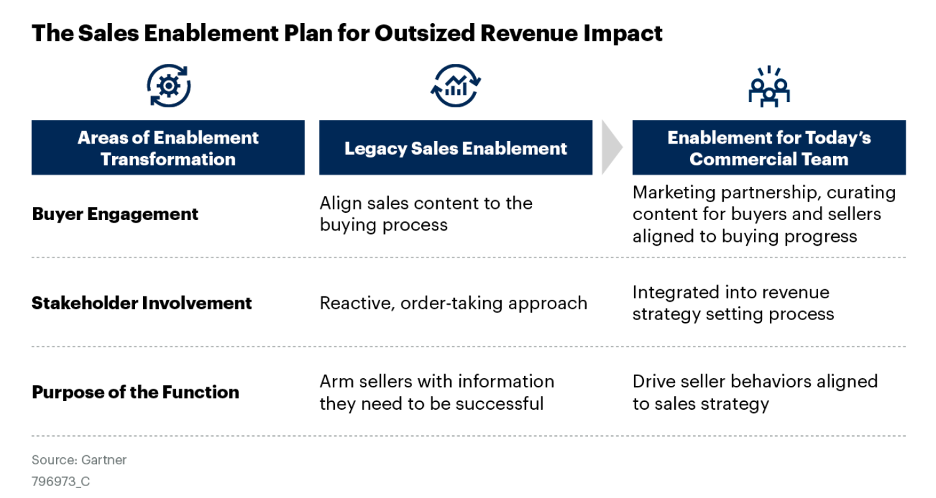
Customer needs and expectations are constantly evolving, and there is a widening gap between seller capabilities and buyer needs. Sellers struggle to adapt to increasingly digital buyer preferences and as a result, sales enablement often fails to meet commercial expectations.
So how can sales leaders turn this around, close this gap and drive seller behaviors that more closely align with sales strategies?
In order to meet revenue goals, sales leaders will need to ignite a new enablement approach that embraces a shift in content as well as dynamic messaging to increase buyer confidence. Furthermore, sales and customer-facing content will need to be closely linked to the buying journey.
To help sales enablement leaders create enablement functions that address today’s commercial realities, Gartner recommends focusing on a three-step plan.
Figure 1. The Sales Enablement Plan for Outsized Revenue Impact

Step 1. Partner with Marketing
Though today’s B2B buyers increasingly prefer a rep-free seller experience, utilizing self-serve digital commerce to complete a purchase, the role of the seller is still vital. However, the seller’s role is changing, and will require them to share valuable context and expertise with buyers rather than simply delivering information in real time.
Sales enablement leaders should partner with marketing to align seller expertise to complement buyers’ digital preferences. This will allow a shift in focus to support the buying journey, moving from simply creating sales content to curating content that speaks to an increase in digital commerce.
Buyer engagement tools created through this partnership allow for a mutually beneficial omnichannel experience, by supporting sellers as they manage change throughout the buying journey. Examples of these tools include:
- Benchmark: Supplies customers hard-to-find data for peer comparison
- Diagnostic: Gives customers a useful framework for assessing performance
- Implementation Guide: Provides steps taken to ensure successful onboarding, deployment and usage
- Connector: Enables stakeholders to establish common ground
Step 2. Build a Proactive, Agile Enablement Function
In order to realize its potential as a strategic partner to the chief sales offer (CSO), sales enablement functions must shift their strategy from reactive to proactive.
Enablement leaders should ask questions such as “How can sales strategy drive the creation and selection of aligned sales kickoff sessions?” and “How can we design a learning program focused on specific seller skills that drive behaviors and accomplish sales goals?”. Probing like this will result in a proactive, strategically aligned function that has a strong voice in setting sales strategy.
A sales enablement charter should also be created to clearly define the enablement function and elevate its role in the sales organization. Details including purpose, ways in which enablement will be measured, and a description of the organization’s structure should be included. By sharing the charter with sales leadership, enablement can ensure strategic alignment and creative initiatives that support sales goals.
Step 3. Drive Seller Behaviors Aligned to Sales Strategy
Sales leaders should look beyond traditional enablement that simply provides information to improve sellers’ capabilities. Instead, enablement must take into consideration the three components of behavior change – ability, motivation and trigger – to drive seller behavior that directly impacts sales objectives.
Triggers, including just-in-time (JIT) learning and behavioral nudges, are often underutilized by enablement leaders as they seek to drive seller behavior change. JIT learning increases seller ability at the moment of action by arming them with the exact information they need to execute, while behavioral nudges are interventions and small tweaks that shape a seller’s behavior in a predictable way.
Leveraging both concepts will spur the right mix of motivation and ability into action, leading to sales organizations that consistently exceed customer acquisition, revenue growth and seller revenue targets.
By following this three-step enablement plan, enablement leaders have the formula to customize content geared towards today’s digital landscape, build a proactive, nimble enablement function, and measure and clearly convey enablement’s impact to the commercial team. Successfully executing this plan elevates the role of enablement where it can take a seat at the leadership table and play an active role in setting sales strategy.
Join Shayne Jackson and Mike Katz to learn more about sales enablement planning at the 2024 CSO & Sales Leader Conference, May 21-22, in Las Vegas.
Get our newsletter and digital focus reports

Stay current on learning and development trends, best practices, research, new products and technologies, case studies and much more.
